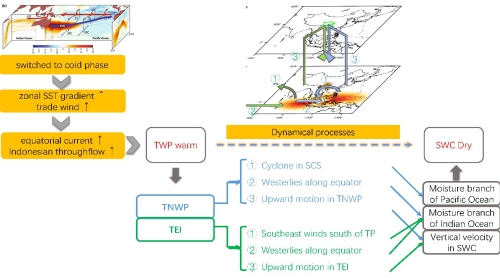In the last decade, a series of severe and extensive droughts have swept across Southwest China (SWC), resulting in tremendous economic losses, deaths, and disruption of society. It is identified that the interdecadal shift of autumn precipitation decisively contributes to the prolonged drying conditions during recent decade in SWC. The autumn climate in Southwest China (SWC) experienced a notable wet-to-dry shift in 1994. Associated with this change in precipitation, decadal signatures of large-scale atmospheric circulation and SST identify a likely dynamical origin: the tropical warm pool (TWP) consisting of tropical northwest Pacific (TNWP, 3°S–12°N and 110°E–150°E) sector and tropical east Indian Ocean (TEI, 10°S–3°N and 80°E–110°E) sector.
During post-1994 period, warm states in the TNWP and TEI sectors plays in a synergistic fashion to invoke dry decades in SWC. On the one side, warm SST over the TNWP sector excites an anomalous cyclone centered on the South China Sea directed opposite to the climatological moisture transport and strengthened zonal wind to its west accompanied by a weakening of the poleward flux; on the other side, warm SST over the TEI sector acts to intensify inflow into TEI with less concurrent transfer of moisture to SWC and to steer moisture to the northern Arabic Sea and away from the SWC-oriented track. Meanwhile, the troposphere over SWC is capped by subsidence, which is jointly contributed by TNWP and TEI. It then follows a reduced moisture supply, suppressed convective activity, and anomalous divergence in SWC, bringing a precipitation deficit there. In contrast, cold TWP SST during 1961–1994 favors wet conditions in SWC, given a perfectly symmetrical circulation pattern. Further, the dominant role of TWP is confirmed, because the modeled response to TWP SST forcing alone bears a great resemblance to the observed evidence. Finally, it is also found that the teleconnected influence induced by TWP is stronger in southern SWC than in northern SWC, which explains the south-north gradient of interdecadal signal of SWC precipitation.
The shift in TWP may be part of long-term pattern of interdecadal oscillation in the climate of Pacific basin, which is known as interdecadal pacific oscillation (IPO). Since 1990s, the IPO has switched to cold phase, coupled with strengthening of zonal SST gradient and accelerated trade wind in the equatorial Pacific Ocean. As a result, firstly, such changes drives additional heat into the western Pacific with concurrent cooling in the eastern Pacific (Maher et al. 2017). This explains the warming in TNWP region. Secondly, such changes result in an increase in the strength and subsequent heat transport of the Indonesian throughflow, which transports some of the additional heat from the western Pacific into the Indian Ocean.
This work was recently published in Climate Dynamics.

Figure 1 Schematic diagram of the driving mechanisms associated with interdecadal dry-wet changes in SWC
Reference
Wang Lin, Huang Gang*, Chen Wen, Zhou Wen, Wang Weiqiang. 2018. Wet-to-dry shift over Southwest China in 1994 tied to the warming of tropical warm pool. Clim. Dyn., doi: https://doi.org/10.1007/s00382-018-4068-8
